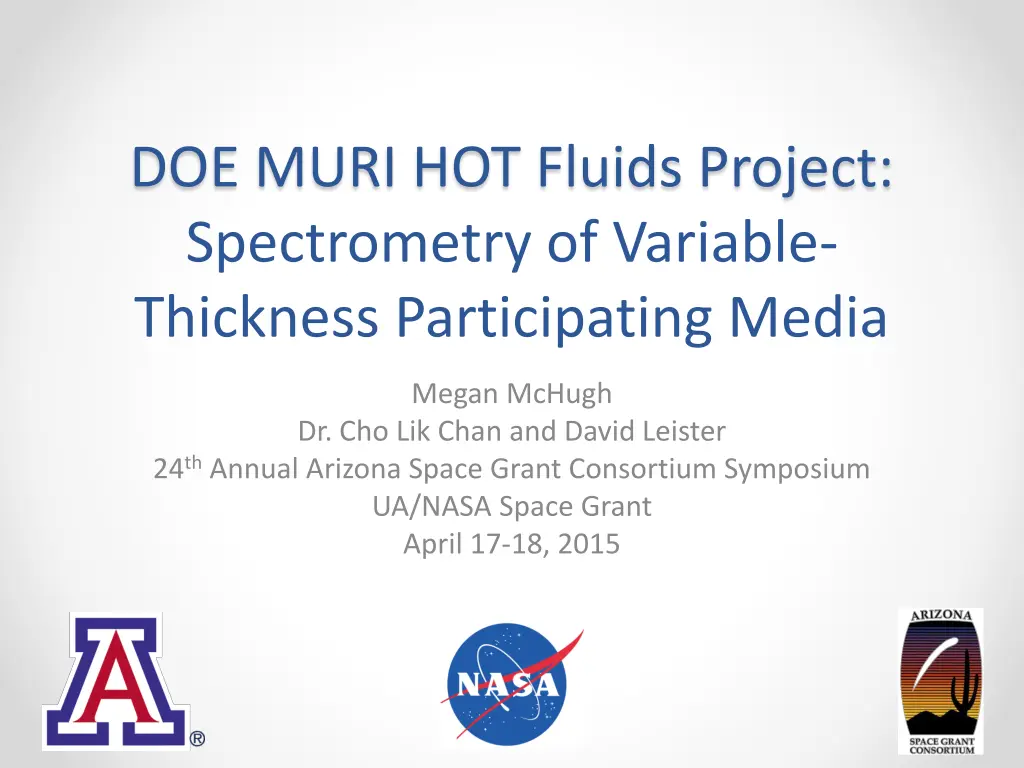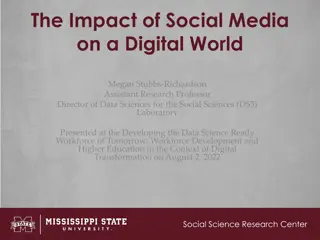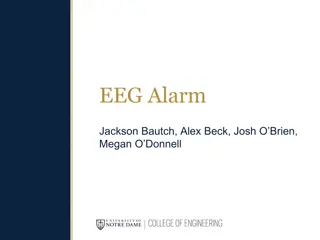
Spectrometry of Variable-Thickness Participating Media in DOE MURI HOT Fluids Project
Explore the DOE MURI HOT Fluids Project focusing on spectrometry of variable-thickness participating media. This project aims to design a method to obtain unique radiation signatures for semi-transparent liquids, contributing to high-temperature applications such as concentrating solar power. The experiment measures transmission across different wavelengths and thicknesses to determine spectral attenuation coefficients. Learn about background scattering mechanisms, Beer's Law, and the setup of the device used in the study.
Download Presentation

Please find below an Image/Link to download the presentation.
The content on the website is provided AS IS for your information and personal use only. It may not be sold, licensed, or shared on other websites without obtaining consent from the author. If you encounter any issues during the download, it is possible that the publisher has removed the file from their server.
You are allowed to download the files provided on this website for personal or commercial use, subject to the condition that they are used lawfully. All files are the property of their respective owners.
The content on the website is provided AS IS for your information and personal use only. It may not be sold, licensed, or shared on other websites without obtaining consent from the author.
E N D
Presentation Transcript
DOE MURI HOT Fluids Project: Spectrometry of Variable- Thickness Participating Media Megan McHugh Dr. Cho Lik Chan and David Leister 24thAnnual Arizona Space Grant Consortium Symposium UA/NASA Space Grant April 17-18, 2015
Introduction Department of Energy (DOE) Multidisciplinary Undergraduate Research Initiative (MURI) High Operating Temperature (HOT) fluids division project o Development of concentrating solar power applications o High-temperature heat transfer fluids Goal: Design a method to obtain unique radiation signatures for participating media. o Participating media was various semi-transparent liquids
Introduction, cont. Experiment: Transmission was measured across wavelengths ranging from 400 to 1000 nm and at twelve thicknesses ranging from 0 to 50 mm to find the spectral attenuation coefficients. o 0, 1, 2, 3, 4, 5, 10, 15, 20, 30, 40, and 50 mm ? ? = ? 0 exp[ ?*x] o I is radiation intensity o is the spectral attenuation coefficient
Background Scattering o Mechanisms: absorption, transmission, reflection o Ways to change direction: diffraction, reflection, refraction The sum of absorption and scattering is known as the attenuation coefficient o ??= ??+ ??,? is the attenuation coefficient is the absorption coefficient sis the scattering coefficient o Dependent on wavelength and the properties of the radiation along the medium o Have units of reciprocal length
Background, cont. Beer s Law: the behavior of these properties along a path, S ??(?) ??(0)= ? ?? I (0) is the incident intensity on a path S (with length units) for a given direction of a medium I (S) is the intensity at a location S for the same direction is the attenuation coefficient described above o
Setup Fig. 2: SolidWorks model of the device. Fig. 1: The structure of the device made from T-Slots. (Photo by Rafael Yari Cabanillas Gonzalez)
Fig. 4: Spectrometer (top) and light source (bottom). (Photo by Rafael Yari Cabanillas Gonzalez) Fig. 3: Design of the device including parts for heat application. (Source: Cabanillas Gonzalez, 2014)
Colored Dyes Attenuation content
Water Attenuation content
Spinach Attenuation content
Red Bell Pepper Attenuation content
Future Directions Perform the same procedure with leaves for remote mapping. o The radiation coming through tree tops can have the parts below the roots reconstructed. o Dr. Ganapol has developed transport theory to perform this remote sensing. o Attenuation data is necessary to make the predictions. Characterize high-temperature fluids for concentrating solar power applications.
Thank you! With special thanks to Barron Orr and Susan Brew, my mentor, Dr. Cho Lik Chan, and my research partner, David Leister.






















